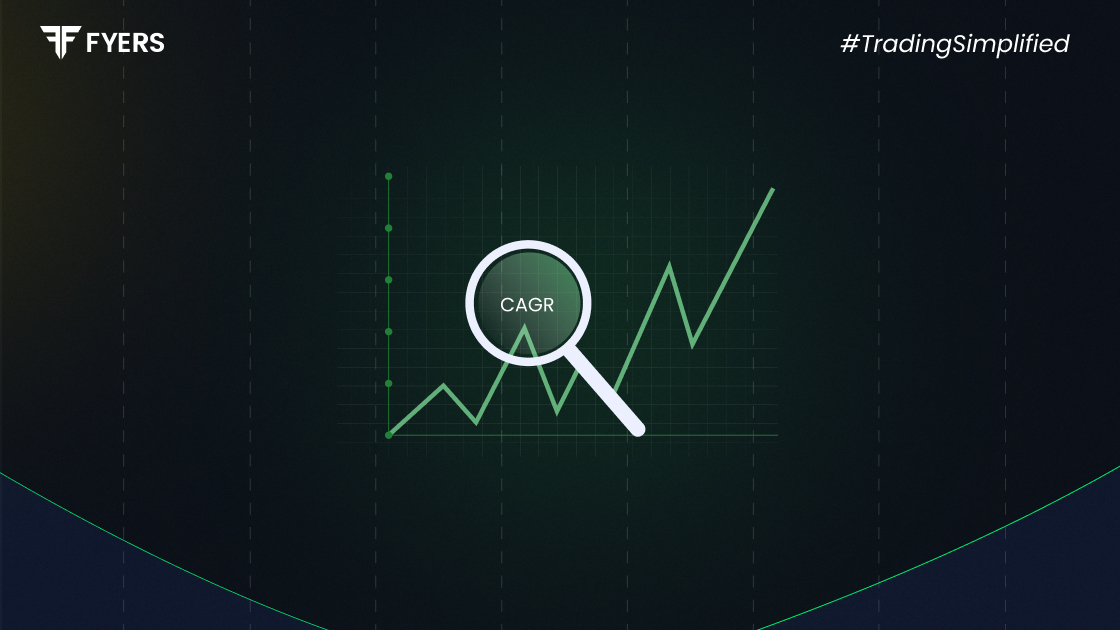

 24 Jun, 2025
24 Jun, 2025
 3 mins read
3 mins read

Understanding how investments or businesses grow over time is crucial for making informed decisions. One widely used metric for measuring consistent growth over a period is CAGR – Compound Annual Growth Rate. It provides a single annual growth rate that describes how an investment or value has increased, assuming it grew at a steady rate each year.
In this post, we’ll explain what is CAGR, how it works, the CAGR formula, examples, and its pros and cons.
CAGR stands for Compound Annual Growth Rate. It refers to the average annual rate at which an investment grows over a period, assuming the profits are reinvested at the end of each year. The CAGR full form is important to know if you're entering the world of finance or investments.
In simple terms, CAGR meaning can be understood as a tool that helps answer: "If my investment grew at the same rate every year, what would that rate be?"
It is often used to track investment returns, business revenue, or any value that changes over time.
CAGR calculates the constant rate of return over a specific period. It smoothens out the fluctuations that might happen each year and gives a clear picture of growth.
It is commonly used for:
Even if actual yearly growth is inconsistent, CAGR shows the average yearly growth over the total period.
The formula to calculate CAGR is:
CAGR = [(Ending Value ÷ Beginning Value)^(1 ÷ Number of Years)] – 1
To express it as a percentage, multiply the result by 100.
Where:
Understanding the CAGR calculation is essential for making long-term investment decisions.
CAGR is used in various scenarios:
If you're unsure how to calculate CAGR, follow the step-by-step formula provided above.
Suppose you invested ₹1,00,000 in a fund, and it grew to ₹1,80,000 in 5 years.
Using the formula:
CAGR = [(1,80,000 ÷ 1,00,000)^(1 ÷ 5)] – 1
CAGR = (1.8)^(0.2) – 1
CAGR ≈ 0.1257 or 12.57%
This CAGR example means the investment grew at an average annual rate of 12.57%.
CAGR is a powerful tool to assess the average annual growth rate of investments or businesses over time. It simplifies complex data into a single growth figure, making it ideal for long-term analysis. However, it's important to recognise its limitations and use it alongside other metrics for a fuller financial picture.
If you're looking to track or compare financial performance over multiple years, CAGR is a dependable and widely recognised metric to begin with.
CAGR full form is Compound Annual Growth Rate. It represents the average yearly rate at which an investment grows over a specified time period, assuming the returns are reinvested each year.
Use the CAGR formula:
CAGR = [(Ending Value ÷ Beginning Value)^(1 ÷ Number of Years)] – 1
Multiply the result by 100 to get the percentage. This is the standard CAGR calculation used globally.
While CAGR assumes steady growth, IRR (Internal Rate of Return) considers multiple cash inflows and outflows and is more suitable for complex investments.
Calculate your Net P&L after deducting all the charges like Tax, Brokerage, etc.
Find your required margin.
Calculate the average price you paid for a stock and determine your total cost.
Estimate your investment growth. Calculate potential returns on one-time investments.
Forecast your investment returns. Understand potential growth with regular contributions.